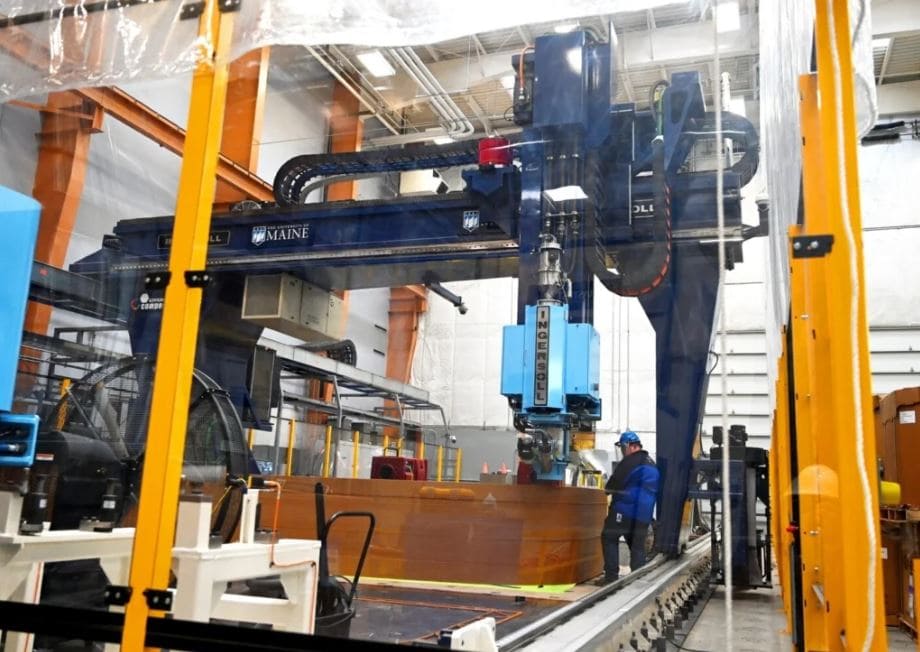University of Maine scientists think they have a groundbreaking solution to the lack of affordable housing: small homes made with wood fiber using a giant 3D printer.
More from the News
Home to the world’s largest polymer 3D printer, the university’s Advanced Structures and Composites Center is developing robotic and artificial intelligence technology to automate construction, which they predict will be faster and less costly than traditional stick-built construction.
The center, which has received $30 million in federal funding and $15 million in state funding, works around the construction industry’s material and labor shortages. The researchers are utilizing Maine wood residuals – which could be scrap lumber, sawdust, construction debris – in the 3D printing process, sidestepping the increased costs of traditional construction materials caused by supply chain disruptions. The center’s founding executive director Habib Dagher calls it “solving a problem using a Maine solution.”
The university’s Advanced Structures and Composites Center hopes to create a prototype house using abundant supplies of wood fiber.
“We’re looking for a radical solution, a different solution, which isn’t going to happen overnight,” Dagher said. “We’re not looking for a quick fix, because there is none.”
The center’s “Factory of the Future” will look almost like a next-generation car manufacturing line, Dagher said. Homes will be built in sections, or modules, and eventually delivered to sites to be assembled.
“The printer’s doing a piece of the project, whereas the other robots are working with the printer to make it all work together,” he said. “Sensors will talk back to the printer, and then the printer has the ability to correct automatically with AI.”
The project coincides with a severe shortage of affordable homes in Maine, fueled in part by rising labor and supply costs.
A report released last month by the Joint Center for Housing Studies of Harvard University said the typical home is unaffordable to median-income residents in all four of the state’s largest metro areas. In the Portland area, the median household income is under $62,000 but the income needed to buy the average home is $130,000, the study found.
In collaboration with MaineHousing, the center is currently building a prototype – a single housing unit, which they hope will be ready for outdoor testing by the end of the year, Dagher said. Eventually, he said, it may be possible to “print” a 600-square-foot house in as little as three days, including the walls, roofing and floors. The technology could someday also be used to create apartment buildings, the researchers said.
Dagher said the goal is for the lifespan of the homes to match or exceed that of conventional housing.
MaineHousing Development Director Mark Wiesendanger said so far, it looks to be weather-proof and insect-proof.
“The fact that it’s made out of natural materials is good not only for the environment, but for the lived environment of the people that (will) live in these properties,” Wiesendanger said. “Doesn’t have the off-gassing of plastics, for instance.”

Unlike most 3D print construction projects, which use concrete, the UMaine center’s project will use a new 3D printing material containing Maine wood fibers that are abundant, particularly because of the closure of paper mills. The center’s researchers are developing the material in partnership with researchers at Oak Ridge National Labs, a Tennessee laboratory sponsored by the U.S. Department of Energy. By developing the new construction material, they’re bringing down construction costs by essentially adding value to low-grade wood residuals that are cheaper than lumber.
The wood materials are converted into wood flour – fine, powdery sawdust – that is bound together by biopolymers, which could be made from corn. The mixture is formed into pellets, which are then melted and extruded by the 3D printer at a controlled temperature. Evan Gilman, chief operations engineer at the ASCC, said it’s “like a hot glue gun,” squirting out the material into a desired shape.
Changing the formulation of the material can change its strength, Dagher said. They’re developing “cellulose nanofibers” – with particles a thousand times smaller than wood flour – that could have properties similar to metals.

Rep. Victoria Morales said this invention, which utilizes Maine’s resources and workforce, holds promise for the state’s economy.
“This is our heritage industry,” Morales said. “We could be a very big player … exporting this product throughout the country.”
The price of lumber and plywood went up 18 percent between December 2020 and December 2021, according to a 2022 Associated General Contractors of America report. Housing developer and advocate Cullen Ryan said costs have increased across the board and wait times for materials have increased.
“We don’t have sufficient resources to create an adequate supply of affordable housing,” said Ryan, executive director of Community Housing of Maine. “If we can figure out a way to do it with less costs, we win.”
Relying on machines instead of manual labor will also allow them to “make more with less people,” Dagher said, which would be significant in the face of labor shortages. For the past two years, the construction industry has been scrambling to recruit and train workers, according to Associated General Contractors of Maine.
Matt Marks, a consultant representing the Associated General Contractors of Maine, said technological advances aren’t a threat to the construction industry’s workforce. It could actually help recruit people to the industry and complement the work of people in the field, said Marks, a principal at consulting firm Cornerstone Government Affairs. People will still be needed in construction, he said, including in the case of UMaine’s 3D printing project.
“You’ll still have carpenters doing modifications, you’ll still have drywall work, electricians, and plumbers,” Marks said. “In a place like Maine, where the shrinking pool of younger folks has been happening since the late 80s … we’re either gonna have to recruit people from outside the Maine border, or attract people who might be in other career paths, like technology, to think about construction as an option.”
Affordable housing developer Nathan Szanton said the construction industry has struggled with older workers retiring and not enough younger workers coming into the field to replace them.
“Younger people seem to prefer jobs that involve technology like computer programming, or jobs that are indoor jobs like in air conditioned settings like working in a call center, rather than working outdoors,” said Szanton, president of The Szanton Company. “It’s hard to find that many people these days who are willing to do hard physical labor.”

Dagher said the center aims to “produce the workforce of the future.” The “Factory of the Future,” which the ASCC is planning to have up and running by 2025, will include a training facility for students and industry professionals to learn how to operate, design and maintain the machines and software involved in automated construction.
“We need to … not only develop the technology, but train the workforce that’s going to be able to operate this equipment,” Dagher said. “What we’re trying to do is develop fundamental solutions to the problems.”
The “Factory of the Future” is projected to be a $90 million facility, half of which has already been secured. Dagher said the center’s goal is to raise the remaining half of the funds in fiscal year 2023. Other investors in the facility include the UMaine System, which has allocated $1.5 million, and the U.S. Department of Defense and Department of Commerce.
Rep. Morales said it’s important for the state to invest in the research university, which she said is “on the cutting edge.” Aside from affordable housing, the ASCC is working on other projects such as floating wind turbines to generate energy at sea and a spacecraft decelerator for NASA’s Mars mission.
“They have the brainpower, they have the energy to be doing this kind of work,” Morales said. “It is going to be key for our state to be investing in the university system as much as possible to continue to boost them so they can do this work and then lead our state in creating these products.”
Subscribe to AM Chronicle Newsletter to stay connected: https://bit.ly/3fBZ1mP
Follow us on LinkedIn: https://bit.ly/3IjhrFq
Visit for more interesting content on additive manufacturing: https://amchronicle.com/


